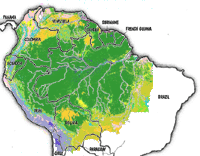Grading and Clearing
One of the main sources of criticism for residential development is when parcels of land are completely cleared before building. As the costs involved with clearing, regrading, and disposal of construction debris continue to rise, there is a natural financial incentive to do things differently than in the past. Preserving natural areas, where practical, can also lessen the need to rely on costly landscaping. Something many development critics do not understand is that the very ordinances that were created to ensure attractive and functional communities often contribute to other problems. Many communities have limitations on the slope of streets, driveways, and even on finished lots. When these requirements get extreme, there has been traditionally only one option -- clear and regrade the entire parcel. This does not have to be standard practice, however. Residential streets can safely be built on slopes as high as 15 percent, and lot slopes can be designed effectively with steep grades as well. The key is to follow the natural contours of the land as much as possible. Minimizing land disturbance works better, of course, if combined with other approaches such as clustering of homes. This technique seeks higher density in a smaller area of the parcel of land. The rest of the site can then be left in a natural state. In some cases, it may even be productive to dedicate the uncleared land for park use or for permanent open space. Grading practices also contribute to the runoff on a site. Practices that encourage sheet flows (as opposed to concentrated flow) across grassy or natural areas reduce runoff. These are options that can usually be employed at the discretion of the developer or designer. In addition to the environmental benefits and direct financial incentives for minimizing clearing activities, there is the possibility of receiving industry and public recognition for these efforts, thus enhancing marketing options. For example, NAHB and the National Arbor Day Foundation have established a program to reward those that build in concert with the natural environment -- the program is called Building With Trees.
Storm Water Management
Another key "green" issue in land development is how to handle storm water. In the past, getting the water off site without causing downstream flooding was the primary objective. Now, the quality of the water leaving a site has become equally important. Fortunately, there are cost-effective approaches to developing land that limit runoff, and subsequently reduce associated pollutants. Minimizing the amount of impervious area is a good first step. This is not only environmentally wise, but can also represent large cost savings. Techniques include eliminating sidewalks on one or both sides of streets, using non-paved driveways, running roof drains to natural swales or grassy areas rather than to a closed storm drain system, and minimizing the width of streets. In many jurisdictions, there is some flexibility for developers in determining whether to pave a driveway or include sidewalks. Gravel pathways may be an alternative to sidewalks where there is concern over pedestrian traffic, but in most residential settings this is not a factor for secondary and local streets. These decisions must be balanced against the desires of potential buyers. Unless you have an unusual ordinance requiring roof drains to be hooked up to a storm sewer, this is also an easy concept to implement. Street widths have the largest impact on runoff and on costs. Unfortunately, most communities have ordinances requiring excessively wide streets. Developers may be able to negotiate changes for a particular development, but will likely have to seek changes to local land development standards to change street width requirements more generally. The publication, Proposed Model Land Development Standards and Accompanying Model State Enabling Legislation (HUD and NAHB Research Center, 1993), includes recommendations for minimum street widths that recognize the cost and environmental benefits of narrower versus wider streets (Figure 1), and other cost-effective development strategies. It also includes recommendations for turnarounds, another location where the pavement area can be reduced. Alternative configurations for turnarounds are shown in Figure 2.

In addition to grading and storm water issues, there are many other green development methods that can be employed. For example, clustering of homes not only helps preserve natural areas but can also minimize costs for utilities and other services. Likewise, there are many alternatives to conventional sewer or on-site disposal that should be considered.
Almost all areas of development are open to innovation, but many will require institutional change to local zoning and development ordinances. Macro-level issues like planning and zoning will likely require a long-term commitment to a process that is often difficult to change. Other site-specific innovations may be feasible under current ordinances. Still other options fall somewhere in between, requiring some type of approval but at perhaps a lower level than the planning and zoning issues. The degree of feasibility for change also depends on the scope of the project in terms of overall size. Before acting on any of the suggestions discussed, it is important to remember to check with local officials and local codes. Also, for development ordinance issues that require institutional changes, consider teaming with other builders through your local or state home builder association to increase the chances of success.


